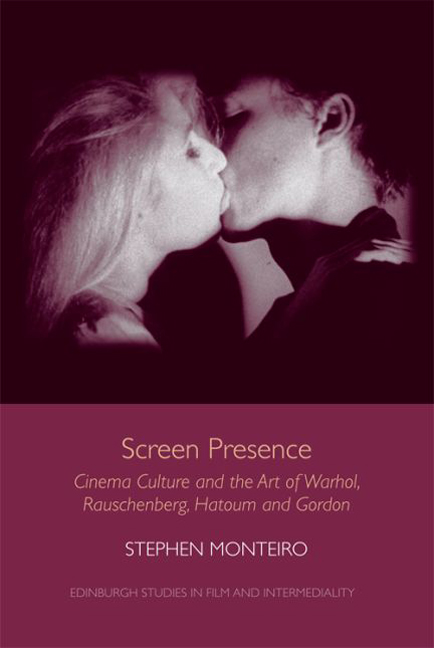Book contents
- Frontmatter
- Contents
- List of Figures
- Acknowledgements
- Introduction: Cinema's Grey Spaces
- 1 A Wider Audience: Robert Rauschenberg, the White Paintings and CinemaScope
- 2 The Screen Scene: Andy Warhol, the Factory and Home Movies
- 3 Private Dis-Pleasures: Mona Hatoum, Mediated Bodies and the Peep Show
- 4 A Monument in Ruins: Douglas Gordon, Screen Archaeology and the Drive-in
- Conclusion
- Index
1 - A Wider Audience: Robert Rauschenberg, the White Paintings and CinemaScope
Published online by Cambridge University Press: 15 September 2017
- Frontmatter
- Contents
- List of Figures
- Acknowledgements
- Introduction: Cinema's Grey Spaces
- 1 A Wider Audience: Robert Rauschenberg, the White Paintings and CinemaScope
- 2 The Screen Scene: Andy Warhol, the Factory and Home Movies
- 3 Private Dis-Pleasures: Mona Hatoum, Mediated Bodies and the Peep Show
- 4 A Monument in Ruins: Douglas Gordon, Screen Archaeology and the Drive-in
- Conclusion
- Index
Summary
On a September evening in 1953, six thousand people gathered outside the Roxy Theater in New York City, matched by nearly as many invited guests, for the world premiere of 20th Century-Fox's The Robe. The turnout likely pleased studio executives, who hoped the event would be remembered less as the premiere of a Technicolor biblical epic starring a young Richard Burton, than as the beginning of a new era in cinema exhibition. The studio had mounted a year-long media blitz promoting The Robe as the debut of CinemaScope, a widescreen projection process meant to transform the way the public saw films and understood cinema. ‘You have read about it … you have heard about it … soon you will see it for the first time’, proclaimed the studio's New York Times advertisement. ‘Nothing you have ever seen in any theatre will match the scope … the spectacle … the power …’
As the post-war success of television cut into film-industry profits, Hollywood gambled that CinemaScope and similar widescreen formats would redefine and rescue the cinema through unprecedented sensorial experiences. Television manufacturers had advertised their products as comparable to cinema (‘A TV picture so clear, so sharp … you'll think you're at the movies!’). Fox sought a fundamental aesthetic shift with CinemaScope, one in which audiences accustomed to viewing images through the clearly demarcated frame of conventional cinema or television would lose their bearings before a large, slightly curved picture plane where the lateral edges of the image exceeded the field of vision. Bolstered by multi-track sound, the new format was meant to weaken the boundaries between picture and exhibition space, immersing the viewer in an environment television could not possibly match.
CREATING SPECTACLE
Although CinemaScope did not ‘simulate third dimension to the extent that objects and actors seem to be part of the audience’, as Fox's marketing department had claimed, The Robe 's Roxy premiere generated favourable reactions overall, and widescreen projection became the most significant change to Hollywood production since the advent of sound in the 1920s. The Robe would have a three-month run at the Roxy, becoming the second-highest grossing film in history.
- Type
- Chapter
- Information
- Screen PresenceCinema Culture and the Art of Warhol, Rauschenberg, Hatoum and Gordon, pp. 19 - 57Publisher: Edinburgh University PressPrint publication year: 2016



